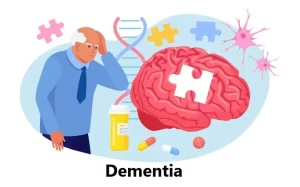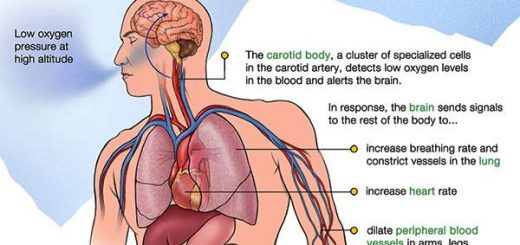Aging and cognition, Dementia symptoms, types, What comes first, dementia or Alzheimer’s?
Dementia is not a disease but it is a group of symptoms associated with memory loss, difficulty thinking, problem-solving, and impaired communication. The most common cause of dementia is Alzheimer’s disease, though there are many other causes, including vascular dementia, Lewy body dementia, frontotemporal dementia, and others.
Dementia
Dementia is a significant and growing healthcare problem as more of the population is living long enough to get it. The main cause of dementia is Alzheimer’s disease, The major risk factor for Alzheimer’s disease is age. It is a general term for a decline in cognitive function severe enough to interfere with daily life.
Among patients with dementia, 50% have Alzheimer Disease alone, 15% have had strokes (vascular dementia), and 15% suffer from both AD and strokes (strokes are common in the elderly). The remaining 20% have dementia secondary to Parkinson’s, natural pressure hydrocephalus (NPH), depression, frontotemporal, Lewy body dementia etc. Frontotemporal and Lewy body dementia are two types of dementia due to the deposition of abnormal proteins.
- Dementia is a progressive, global decline in cognitive and behavioral functioning that interferes with daily living activities and social relationships (Brain Failure).
- Senile Dementia is an outdated term once used to refer to any form of dementia that occurs in older people.
- Presenile Dementia (also no longer used).
- Age-associated memory impairment is a decline in short-term memory that sometimes accompanies aging (benign senescent forgetfulness), now it is called minimal cognitive impairment (MCI).
Common Symptoms of Dementia
- Memory Loss: Especially forgetting recent events, names, and places.
- Difficulty with Problem-Solving: Struggling to follow plans, and recipes, or manage once-easy tasks.
- Disorientation: Confusion about time, place, or familiar environments.
- Language Problems: Difficulty finding the right words, following conversations, or communicating clearly.
- Mood Changes: Depression, anxiety, or personality shifts may occur.
- Decreased Judgment: Reduced ability to make decisions, leading to poor financial or safety choices.
Types of Dementia
- Alzheimer’s Disease: The most common form, marked by the buildup of plaques and tangles in the brain.
- Vascular Dementia: Caused by reduced blood flow to the brain, often after a stroke or small vessel disease.
- Lewy Body Dementia is characterized by abnormal protein deposits (Lewy bodies) in the brain.
- Frontotemporal Dementia: Affects personality, behavior, and language due to degeneration in the frontal and temporal lobes of the brain.
- Mixed Dementia: A combination of different types, often Alzheimer’s and vascular dementia.
Risk Factors of Dementia
- Family History: Genetics can play a role, particularly in early-onset Alzheimer’s.
- Cardiovascular Factors: High blood pressure, diabetes, and high cholesterol increase the risk.
- Lifestyle: Smoking, physical inactivity, poor diet, and excessive alcohol can contribute to dementia risk.
Diagnosis and Treatment
There’s no single test to diagnose dementia. Physicians use a combination of medical history, physical exams, neurological tests, and brain imaging (like MRIs or CT scans) to identify the condition.
- Medications: Such as cholinesterase inhibitors for Alzheimer’s or drugs for managing mood and behavior.
- Cognitive Therapies: To help with memory and problem-solving.
- Lifestyle Adjustments: Healthy eating, regular exercise, mental stimulation, and social engagement can slow progression.
- Early diagnosis can improve quality of life by allowing for better planning and support.
Dementia statistics
- 5-15% over the age of 65 is demented.
- 20-50% over 85 is demented.
- 60-80% of demented have Alzheimer Disease.
Alzheimer’s Disease
Risk Factors
- Old age.
- Positive family history/Genetic ApoE4 (apolipoprotein Epsilon e gene, related to cholesterol metabolism) + AD.
- Female gender (Estrogen is not only protective for your heart, joints, and bones, it’s also important for the brain) so AD is common in postmenopausal women.
- Rural populations.
- Level of education: If we keep on using our brain, stimulating it, it causes the release of factors, particularly nerve growth factor, that leads to the development of nerve radicals “If you don’t use it, you will lose it”, So doing a crossword, puzzles, Reading engaging in stimulant conversations as well as exercise can keep our brain healthy.
- Typical patients of AD = Post-menopausal women of low-level education from the countryside.
- Environmental factors: Aluminum, zinc, viruses, and prions like Mad Cow Disease and Creutzfeldt-Jakob disease (CJD),
- Diet + nutritional factors (thiamine, fatty acids), a diet with a vitamin B complex is protective.
- Head injury as in traffic accidents and some occupations like boxing.
- Down’s Syndrome if they lived long enough.
- Diabetes Mellitus.
- Hypertension.
- Obesity.
Certain features that suggest a diagnosis of dementia other than Alzheimer’s disease
Most important:
- Abrupt onset.
- Vascular dementia.
- Profound aphasia.
- Fronto-temporal dementia.
- Extrapyramidal signs or Gate.
- Parkinson’s syndrome.
- Eye movement abnormality.
- Supranuclear palsy and Lewy body dementia.
Nothing can tell 100% that the patient has AD except after taking a brain biopsy after his death, but we diagnose clinically by using:
- A questionnaire.
- PET scan (amyloid and tau.scan)
- MRI = Scan the memory organ in the brain (hippocampus) for atrophy in the early stages of the disease.
Pathophysiology
AD is characterized by:
- Development of senile plaques and neurofibrillary tangles.
- Neuronal destruction, particularly in cholinergic neurons.
Two microscopic changes occur in the brain:
- Senile plaques (composed of b-amyloid polypeptides) between neurons stimulate apoptosis).
- Neurofibrillary tangles (composed of a protein tau, links together to form filaments) in neurons.
The cause is not known but the most probable hypothesis is the amyloid cascade hypothesis, which progresses from amyloid precursor proteins through multiple secondary steps to cell death, this forms the foundation for emerging options for treatment (vaccines, alpha and gamma-secretase inhibitors but of po success), so 2 pathognomonic features of senile plaques with microglial activation and Neurofibrillary tangles are present.
Diagnostic criteria
Cognitive impairment is severe enough to cause social or occupational disorders in at least two domains:
- Memory.
- Language.
- Calculations.
- Orientation.
- Judgment.
Recognition
- How important is early detection and diagnosis of AD?
- Early warning signs include:
- Gradual loss of short-term memory.
- Mood or personality changes.
- Problems finding or speaking the right word.
- Inability to recognize objects.
- Forgetting how to use simple, ordinary things, such as a pencil.
- Forgetting to turn off the stove, close windows, and lock doors.
Evaluation
- History (family, friends)_degree of change in activity daily living, and in personal behavior.
- Physical examination. To exclude mimics of dementia as severe hypothyroidism (myxedema madness), severe alcohol abuse (Alcoholic dementia), and severe anemia) can cause loss of memory, fatigue and apathy, and severe vitamin B deficiency.
- Cognitive assessment by mini-mental state examination to assess attention, memory, executive function, language, and Visuospatial.
- Laboratory tests (CBC, TSH, Vit B12, folic acid).
- Imaging studies (PET scan, MRI, but the gold standard is biopsy).
- Special tests.
Management
A. Medical:
- Prevention.
- Reversal (intoxication, depression, cerebral lesions).
- Stabilization/ slowing of progression: Acetylcholinesterase inhibitors, Anti-inflammatory, and Estrogen.
- Treating Behavioral Problems.
B. Functional (Cueing and scheduling) activity used to help the memory of an individual.
C. Psychosocial.
D. Education
E. Care of the family (After about 5 years 50% of the caregivers of Alzheimer disease suffer from depression).
F. On-going care
Future hope
Reducing amyloid production, aggregation, or enhancing its removal are promising avenues for treatment (immunization and secretase inhibition).
You can follow science online on YouTube from this link: Science online
You can download Science Online application on Google Play from this link: Science online Apps on Google Play
Causes of Falls in the elderly, How to prevent falls and Why do the Elderly die after a fall
Urinary incontinence in elderly causes and treatment, How to correct urinary incontinence?
Properties of cardiac muscles, Cardiac automaticity, and Conduction of electrical impulses
Histology of the heart, Cardiomyocyte types, Ultrastructure, and features of cardiac muscle fibers
Mediastinum contents, Aorta parts, Brachiocephalic trunk, Pulmonary trunk, and Thoracic duct trunk
Electrocardiogram (ECG) importance, ECG test results, analysis and abnormalities
Heart and Pericardium structure, Abnormalities, and Development of the heart
Heart function, structure, Valves, Borders, Chambers and Surfaces
Cardiac Markers review, definition, list, test, and myoglobin function




